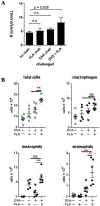TLR5 Activation Exacerbates Airway Inflammation in Asthma
- PMID: 32060608
- PMCID: PMC7123460
- DOI: 10.1007/s00408-020-00337-2
TLR5 Activation Exacerbates Airway Inflammation in Asthma
Abstract
Introduction: Innate immune activation through exposure to indoor and outdoor pollutants is emerging as an important determinant of asthma severity. For example, household levels of the bacterial product lipopolysaccharide (LPS) are associated with increased asthma severity. We hypothesized that activation of the innate immune receptor TLR5 by its bacterial ligand flagellin will exacerbate airway inflammation and asthma symptoms.
Methods: We determined the effect of flagellin co-exposure with ovalbumin in a murine model of allergic asthma. We evaluated the presence of flagellin activity in house dust of asthma patients. Finally, we analyzed the association of a dominant-negative polymorphism in TLR5 (rs5744168) with asthma symptoms in patients with asthma.
Results: We showed that bacterial flagellin can be found in the house dust of patients with asthma and that this bacterial product exacerbates allergic airway inflammation in an allergen-specific mouse model of asthma. Furthermore, a dominant-negative genetic polymorphism in TLR5, the receptor for flagellin, is associated with decreased symptoms in patients with asthma.
Conclusion: Together, our results reveal a novel genetic protective factor (TLR5 deficiency) and a novel environmental pollutant (microbial flagellin) that influence asthma severity. (Clinical trials NCT01688986 and NCT01087307).
Keywords: Airway inflammation; Asthma; Flagellin; TLR5.
Conflict of interest statement
The authors have no conflicts of interest regarding this work.
Figures





References
-
- Hawn TR, Verbon A, Lettinga KD, Zhao LP, Li SS, Laws RJ, Skerrett SJ, Beutler B, Schroeder L, Nachman A, Ozinsky A, Smith KD, Aderem A. A common dominant TLR5 stop codon polymorphism abolishes flagellin signaling and is associated with susceptibility to legionnaires’ disease. The Journal of experimental medicine 2003; 198: 1563–1572. - PMC - PubMed
-
- Blohmke CJ, Park J, Hirschfeld AF, Victor RE, Schneiderman J, Stefanowicz D, Chilvers MA, Durie PR, Corey M, Zielenski J, Dorfman R, Sandford AJ, Daley D, Turvey SE. TLR5 as an anti-inflammatory target and modifier gene in cystic fibrosis. J Immunol 2010; 185: 7731–7738. - PubMed
Publication types
MeSH terms
Substances
Associated data
Grants and funding
LinkOut - more resources
Full Text Sources
Medical
Research Materials

